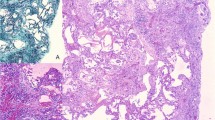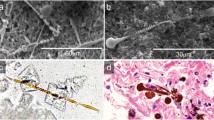Abstract
THE occurrence of pleural and peritoneal mesotheliomata is linked with the inhalation of asbestos fibres1,2. Experimentally, mesotheliomata have been induced by the intrapleural inoculation of asbestos fibres into rats3. These findings suggest that the incorporation of the fibres disturbs processes at the cellular level. The possibility that they induce chromosome abnormalities was indicated by V. Timbrell (personal communication) and we have investigated it further using cultured Chinese hamster cells.
Similar content being viewed by others
References
Wagner, J. C., Gilson, J. C., Berry, G., and Timbrell, V., Br. med. Bull., 27, (1971).
Biological Effects of Asbestos, IARC Scientific Publications No. 8. (International Agency for Research on Cancer, Lyons, 1973).
Wagner, J. C., Berry, G., and Timbrell, V., Br. J. Cancer, 28, 173 (1973).
Alam, M. T., et al., Chromosoma, 49, 77 (1974).
Iwakata, S., and Grace, J. T. H., N. Y. State J. Med., 64, 2279 (1964).
Seabright, M., Lancet, ii, 971 (1971).
Author information
Authors and Affiliations
Rights and permissions
About this article
Cite this article
SINCOCK, A., SEABRIGHT, M. Induction of chromosome changes in Chinese hamster cells by exposure to asbestos fibres. Nature 257, 56–58 (1975). https://doi.org/10.1038/257056a0
Received:
Accepted:
Published:
Issue Date:
DOI: https://doi.org/10.1038/257056a0
- Springer Nature Limited
This article is cited by
-
Genomic Landscape of Pleural Mesothelioma and Therapeutic Aftermaths
Current Oncology Reports (2023)
-
The molecular epidemiology of asbestos and tobacco in lung cancer
Oncogene (2002)
-
Biological effects of naturally occurring and man-made fibres: in vitro cytotoxicity and mutagenesis in mammalian cells
British Journal of Cancer (1999)
-
Formation of a clastogenic factor by asbestos-treated rat pleural mesothelial cells
Agents and Actions (1991)





